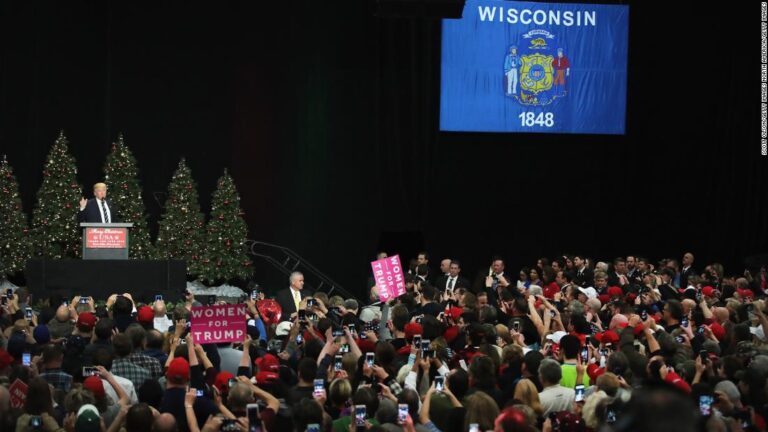(CNN) Donald Trump's success in the Upper Midwest — especially his victories in Michigan and Wisconsin — were critical to his success in the 2016 presidential election.
His 1.5-point loss in Minnesota was the closest a Republican presidential candidate has come to winning the state since Ronald Reagan lost the state by 0.2 points in 1984.
But with Michigan holding its primary last week and Minnesota and Wisconsin voting on Tuesday, it's become clear that 2018 is an entirely different cat. Trump's triumphs in the Upper Midwest haven't carried over for Republicans this cycle.
Polls show Democrats in good shape in the Senate and governorships in all three states. This is yet another indication that the political environment at the national level is on the Democratic side.
Let's start with the Senate race in the state where haunted Hillary Clinton: Wisconsin. Trump became the first Republican presidential candidate to win the state since Reagan in 1984. At the same time, Republican Sen. Ron Johnson held off Democrat Russ Feingold in the state's U.S. Senate race. This might have led you to believe that first-term Democratic Sen. Tammy Baldwin would be in trouble for re-election in 2018. She may well end up in jeopardy, but she certainly isn't right now.
Baldwin is well ahead of the two candidates most likely to win the Republican nomination on Tuesday. He has led Kevin Nicholson or Leah Vukmir in every poll by at least 9 points. The average raised it by double digits and over 50%. Historically speaking, candidates in Baldwin's electoral seat at this point have won about 90% of the time. This is not a game, but it makes her a big favorite.
Across the border in Minnesota, Republicans are having no luck in that state's Senate races either. Democratic Sen. Amy Klobuchar was always going to be a tough target, and the poll averages her by more than 20 points. Republicans had some hope they could unseat Democratic Sen. Tina Smith in a special election. After all, Smith was replacing disgraced former senator Al Franken. No competitive race has yet developed.
Smith has jumped out to a 9-point average lead over potential opponent Karin Housley. That said, Republicans are probably better off picking up a Senate race in the district.
Even in Michigan, where the Republicans are excited for them candidate John James, the polling doesn't look particularly good. Democratic Sen. Debbie Stabenow has posted double-digit gains in every poll in the race so far. The poll average has her ahead by more than 15 points.
Of course, one could argue that it's not all that impressive that Democrats are winning these Senate races. All have incumbents of one form or another, and they are very hard to beat the incumbents of the opposition party in between.
In none of these three states, however, are there any incumbent Democratic governors running for re-election. Michigan and Minnesota have no providers on either side. In Wisconsin, Republican Governor Scott Walker is seeking a third term.
But Walker may find his time is up. Walker actually trails his most likely Democratic challenger, Tony Evers, by about 5 percentage points in a simple average of polls over the past two months. Now, match scorers still think Walker is a slight favorite for re-election, and polls underestimated Trump by about 5 points in Wisconsin in 2016. However, Walker never polled as badly in 2010, 2012 (during a failed attempt to recall) or 2014. If not Otherwise, this looks like the toughest campaign Walker has faced in eight years.
Republicans have no better luck in Minnesota. Former Republican Gov. Tim Pawlenty wants to get back into the governor's mansion. Democrats have a competitive primary from which Erin Murphy, Lori Swanson or Tim Walz are likely to emerge. All three have led Pawlenty in the polling average by at least 8 percentage points. And remember, the non-White House gubernatorial candidate has typically gained ground in the bottom line compared to the polls at this point in the campaign — which would benefit Democrats.
Finally in Michigan, Democrat Gretchen Whitmer regularly leads Republican Bill Swett in the polls. Her lead was generally between 5 and 10 percentage points, although there were many undecideds. The large number of undecided voters gives Schuette an opening. Even with that opening, Whitmer should be considered more likely to win given her lead and that she has led in every race poll taken this year.
Indeed, a steady Democratic lead in the 5 to 10 point range is what we had looking nationally also. We don't know if that advantage will hold as we get closer to the election. If Republicans start gaining ground, we'll likely see it in the Upper Midwest. The district was the site of a Democratic collapse two years ago, and this swing district appears at this point to be the site of a Democratic resurgence for 2018.

